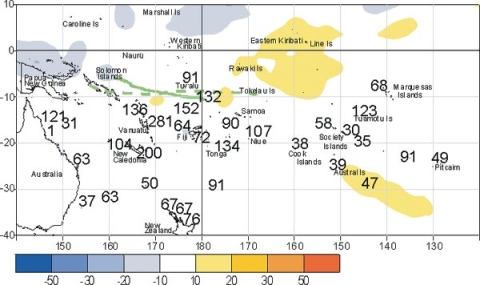Climate developments in July 2003
Extremely high rainfall over parts of New Caledonia and Vanuatu Below average rainfall in many islands from Kiribati to French Polynesia
The SPCZ was active west of the Date Line, extending from east of the Solomon Islands toward southern Tuvalu. However, there was little activity in the east. Enhanced convection occurred over Papua New Guinea. Rainfall was at least 200% of average over much of New Caledonia (some locations recording as much as 500 mm) and parts of Vanuatu. Rainfall was also above average in parts of Tonga and areas of the Tuamotu Islands of French Polynesia. The anomalous rainfall in parts of New Caledonia was result of torrential rainfall over the 15th and 16th of July. Tadine recorded 495 mm over that period, with 422 mm on the 15th, a new 1-day record and 285 mm in 6 hours. Rainfall over Vanuatu was more evenly spread throughout the month.
Areas of suppressed convection and below average rainfall persisted along the equator from Eastern Kiribati to the west coast of South America and also in much of the region from Kiribati to French Polynesia, with many sites recording less than 50% of average rainfall. Rainfall was also below average in parts of Fiji, the Tasman Sea, and over much of New Zealand. Parts of Fiji have now had 4 to 6 consecutive months with below average rainfall.
Air temperatures were near average throughout much of the tropical Southwest Pacific, consistent with most sea surface temperature anomalies. However, they were at least 0.5 °C above average in Tuvalu and more than 1.0°C above average in the Southern Cook Islands.
Climate extremes in July 2003
| Country | Location | Rainfall (mm) | % of average | Comments |
|---|---|---|---|---|
| New Caledonia | Ouloup/Ouvea | 190 | 200 | Well above average |
| New Caledonia | Ouanaham/Lifou | 500 | 471 | Extremely high |
| New Caldedonia | Poindimie | 346 | 247 | Well above average |
| New Caldeonia | La Roche/Mare | 497 | 507 | Extremely high |
| New Caledonia | La Tontouta/Paita | 140 | 205 | Well above average |
| New Caledonia | Noumea | 170 | 200 | Well above average |
| Vanuatu | Bauerfield | 163 | 212 | Well above average |
| Vanuatu | Port Villa | 191 | 281 | Well above average |
| Australia | Townsville Airport | <1 | 1 | Extremely low |
| Fiji | Rarawai Mill/Ba | 6 | 16 | Well below average |
| Country | Location | Mean Air Temp (°C) | Dep. from Av | Comments |
|---|---|---|---|---|
| Cook Islands | Rarotonga Airport | 23.6 | +1.4 | Well above average |

